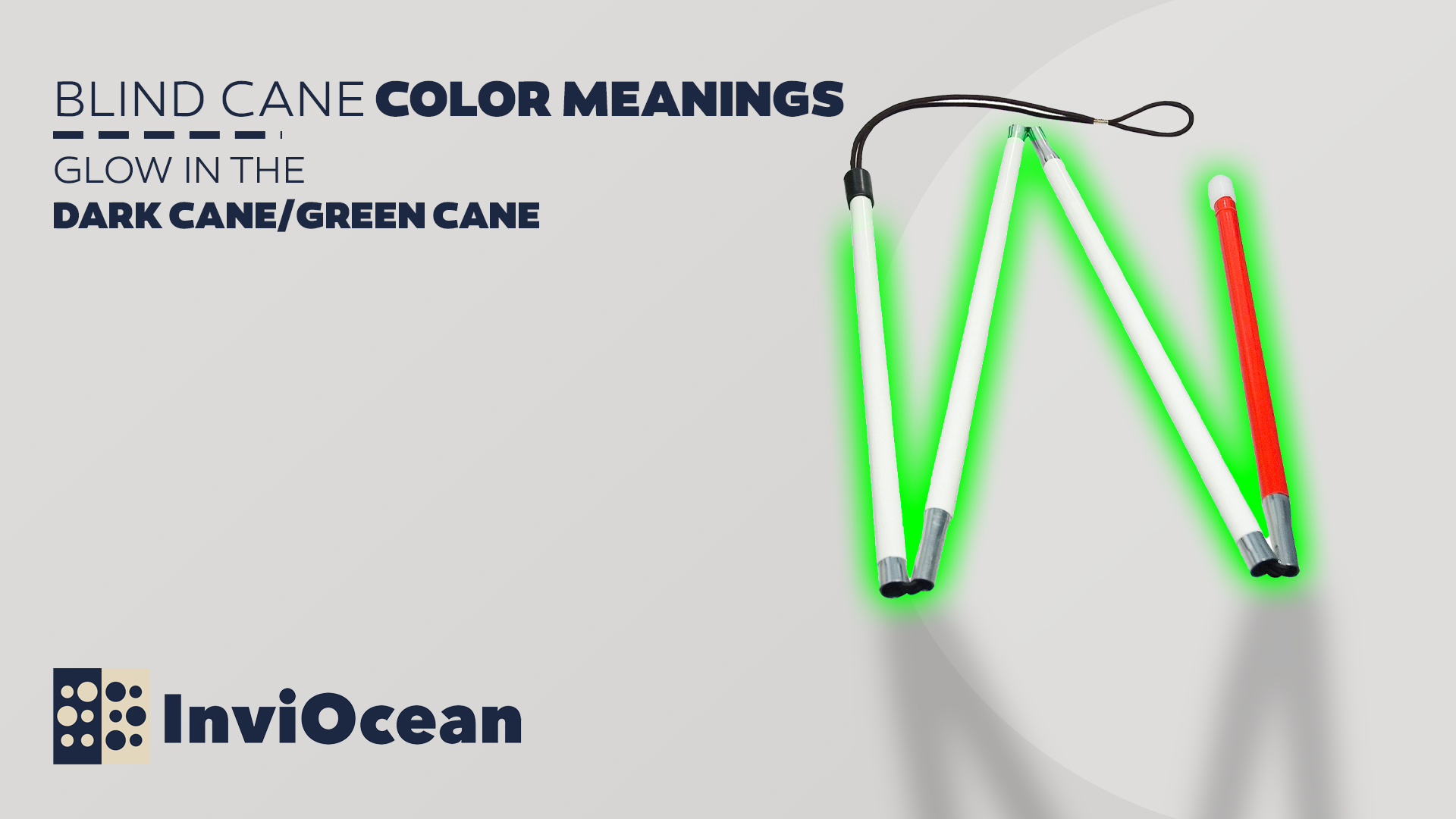Blind cane color meanings: Comprehensive guide
Navigating the world with limited or no vision is a unique journey that demands innovative solutions. Among the tools that empower individuals with visual impairments, the blind cane stands out as an essential companion. Beyond its fundamental purpose, the color of a blind cane carries significant meanings, acting as a silent communicator in the realm of the visually impaired. In this article, we delve into the details of blind cane color meanings, exploring how they serve as valuable indicators, offering insights into the user’s specific needs and circumstances. The comprehensive guide delves into the intriguing realm of blind cane color meanings, shedding light on the nuanced language embedded in these essential mobility tools.
What are blind canes?
The inception of the blindness cane in 1921 is attributed to James Biggs, a photographer who, after losing his vision in an accident, ingeniously painted a walking cane white. This adaptation not only facilitated his navigation within his home but also made his cane prominently visible to others. A decade later, blindness canes made their debut in North America in 1931, evolving over time to embrace a spectrum of colors beyond the original white.
In the pursuit of standardization, organizations dedicated to blindness, orientation and mobility (O&M, the study of visually impaired navigation), and safety have sought to establish guidelines for blindness cane colors. They suggest that certain color combinations can identify the level of a person’s usable vision. Today, we delve into the most prevalent blindness cane color combinations, exploring the associated levels of usable vision. It’s essential to note that individuals may choose cane colors that do not strictly align with their level of usable vision, adding a personal dimension to this visual language. But first, let’s learn what the types of blind canes are.
Types of canes

Symbol Cane
Symbol canes, smaller in size compared to other mobility canes, serve as visual indicators to make others aware of the user’s vision impairment. Primarily symbolic, these canes alert drivers and pedestrians to exercise extra caution when interacting with the user. Lighter and more compact than long canes, symbol canes can be easily folded and stowed in a bag or pocket when not in use. While not designed for significant mobility assistance, some users may employ symbol canes to check for elements like stair edges or door frames.

Guide Cane
Longer than a symbol cane, the guide cane provides basic protection and extends from the floor to the user’s waist. Offering information about the surroundings, it aids in scanning for obstacles like kerbs and steps. The guide cane can be used diagonally for added protection, warning the user of immediate obstacles. It may feature a roller tip for versatile travel, especially in unfamiliar or uneven terrain. Collapsible for convenience, proper training from a rehabilitation officer is recommended for correct usage and safety.

Support Cane
Designed for physical support and stability, the white support cane also signals the user’s sight loss. The cane’s white color serves a dual purpose, indicating both support and vision impairment. Measured for correct height, support canes come with various handle styles and may be collapsible. Individuals are advised to undergo assessment by a physiotherapist to ensure proper cane height and usage.
Blind cane color meanings

White Cane with a Red/Colored Bottom
A white cane with a red tip means more than a color choice. A reflective white cane with a red tip or other colored bottom segment is commonly linked with individuals experiencing low vision, legal blindness, or possessing some usable vision. The colored segment serves a practical purpose in navigating surfaces like curbs and provides enhanced visual contrast for bystanders or motorists. While red remains the most prevalent color for the bottom segment, custom variations, such as purple and pink, add a personal touch to the cane. The collapsible design allows for easy storage in a backpack or on a wall when not in use, making it a versatile choice.
This color combination represents the most widespread choice for blindness canes in the United States, suitable for individuals with no usable vision as well as those who are blind. It also serves as the inspiration for the blindness cane Emoji design.

Solid White Cane
What does white cane mean? White cane meaning is emblematic of individuals who identify as “total” or blind, lacking usable vision. This traditional cane, often made of fiberglass or aluminum, features a solid metal tip and a smooth white finish. Endorsed by the National Federation for the Blind, it is the quintessential image when people think of a blind cane. Telescopic variations offer compactness for short-distance walks or when guided by a sighted companion. The white cane has also been prominently featured in TV and movies, cementing its status as a symbol of visual impairment.

Striped Cane
When choosing a cane, considerations arise about what color cane for a blind person would best suit their preferences and practical requirements. The striped cane, with its red and white candy-cane-like pattern, finds utility among individuals who are deafblind, experiencing both vision and hearing loss. Recognized globally as a symbol of deafblindness, it also serves those with vision loss traveling alongside someone with hearing loss. The red and white stripes hold significance, as acknowledged by the World Federation of the Deafblind.

Glow in the Dark Cane/Green Cane
While all blindness canes possess reflective coatings for visibility in the dark, some users opt for a glow-in-the-dark or light-up cane. The green glow-in-the-dark cane, paired with a reflective red bottom segment, adds visibility. Despite the appeal of innovative designs, a bulkier glow-in-the-dark cane proved less tactile, leading to a return to a traditional cane for adequate sensation. In countries like Argentina, a green cane indicates low vision, differentiating it from the white cane, symbolizing blindness.
Other Colors of Blindness Canes
Blindness canes are available in various solid colors, including yellow, black, and blue, though non-white canes may not catch the attention of car drivers as effectively. A yellow cane with a colored bottom segment, for instance, facilitates easy location in crowded settings. Regardless of color, all blindness canes feature reflective tape for heightened visibility. Studies favoring the visibility of white canes, especially by drivers, prompt a preference for white canes with a colored bottom segment in outdoor settings or areas with high traffic.
In conclusion, exploring the nuanced world of blind cane color meanings reveals a profound language embedded in these essential mobility tools. The question of what color is a blind person’s cane is multifaceted, with various hues carrying different connotations and meanings. From the symbolic nature of the white cane to the practicality of colored segments, each hue communicates a unique message about the user’s visual impairment. The comprehensive guide delves into the significance of various cane colors, shedding light on how they not only aid individuals in navigating the world but also serve as powerful symbols that demand awareness and understanding from those around them. Ultimately, this comprehensive guide seeks to bridge the gap of understanding, encouraging a world where the language of blind cane colors is universally acknowledged and respected. By embracing the symbolism within each cane, we take a step towards a more inclusive society, where the colors serve not only as navigational aids but as beacons of awareness and empathy.
Mobility canes, a type of assistive device, empower individuals who are blind or visually impaired to navigate their daily activities, especially in unfamiliar environments. Many individuals with visual impairments utilize white mobility canes to enhance their mobility and independence.
Canes, much like hats, were once integral to one’s personal accessories. The commonplace black canes of the past did not distinctly signal blindness to sighted individuals, leading to potential accidents.
A green cane is employed in certain countries, like Argentina, to indicate that the user has low vision, while the white cane signifies complete blindness.
